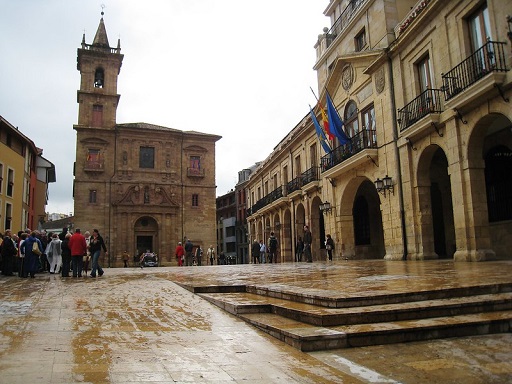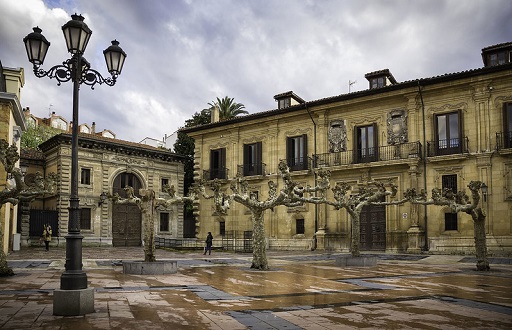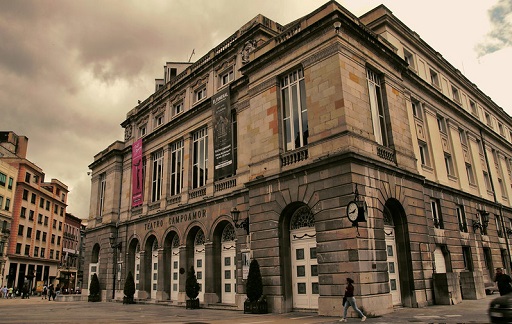What to visit in Oviedo?

Oviedo Cathedral
The Holy Church Basilica Metropolitan Cathedral of San Salvador, what is it called, It is predominantly Gothic in style, although it presents constructive characteristics from the pre-Romanesque to the Baroque.
Its architecture aims to express, symbolically, the desire for God that resides in the heart of man and that is manifested through an impulse towards infinity expressed in a volumetry with a tendency towards the top.
The Cathedral has numerous attractive elements, although the most valuable space is the Holy Chamber, where religious relics such as the Holy Ark or the Victoria Cross are located.
Address: Alfonso II Square

Museum of Fine Arts of Asturias
The most important art museum in Asturias that occupies nothing more and nothing less than 3 buildings, The Velarde Palace, the House of Oviedo-Portal and the extension in the House of Solís-Carbajal.
There are extensive and interesting collections of works and authors with names like El Greco, Dalí, Goya, Picasso and Zurbaran. A selection of authors from the fourteenth to the twenty-first century.
Address: Calle Sta. he

Archaeological Museum of Asturias
Located in the old monastery of San Vicente, It is a state-owned institution, attached to the Ministry of Culture and since 1991 its management has been transferred to the Principality of Asturias.
In the museum we can take an interactive journey from prehistory to the times of the Kingdom of Asturias. Next to the Museum of Fine Arts, It is another of the must-visit museums.
Address: Saint Vincent Street

Constitution Plaza
In the Plaza de la Constitución we can find the Oviedo City Hall built on the old city wall and the Church of San Isidoro, built in the 16th century.
It is a central area of Oviedo just 5 minutes from the cathedral.
Address: Constitution Plaza

Church of Saint Isidore
It is a church and parish located in the Plaza de la Constitución. It has its antecedents in the missing Romanesque church of San Isidro, which currently only preserves the arch of the access doorway..
His Jesuit typology of a ship of 4 sections with open side chapels connected to each other.
Address: Constitution Plaza

Trascorrales Square
Next to the Plaza de la Constitución we find the most picturesque urban space in Oviedo. Its colorful buildings and peaceful environment make it a unique resource.. In the middle of the square we can find some symbolic statues of the Donkey, the Milkmaid and the Fish Seller and the Fishwife.
Address: corral square

Market and Plaza of El Fontán
The market was built at the end of the 19th century on top of the Jesuit college and contains a glass structure that contains various shops and establishments to enjoy Asturian gastronomy..
Square, located in the heart of the market, It was built in the 18th century. The façade has been rehabilitated several times.
Address: bow street shoes

Oviedo University
Conceived in the 16th century by the Catholic Archbishop Fernando Valdés Salas, It is one of the first universities in Spain. The statue of Fernando Valdés Salas is located in the center of the patio.
One of the curiosities of the university are the bullets in the walls due to the revolution of the miners of 1934.
Address: san francisco street

Scandalera Square
The Plaza de la Escandalera that links the commercial area, the old town and the political center of the city, It is known for the presence of the Campoamor Theater, place where the ceremony of the Princess of Asturias Awards is held; the Caja de Asturias or the Thermometer Building.
In this square is the commemorative plaque to the old carbayón that was in that place for centuries until its demolition in 1879. There is also the statue La Maternidad by Fernando Botero.
Address: Scandalera Square

Campoamor Theater
It was founded in 1892 and created to represent operas and theatrical performances due to the floating bourgeoisie that was beginning to be found in the city. Today it is known for the celebration of the Princess of Asturias Awards event.
Operatic activities are currently held throughout the year, in summer theatrical visits are added.
Address: Pelayo Street

Palace of exhibitions and congresses
Designed by the famous architect Calatrava in 2011. Has a concrete surface, steel and glass in the shape of a shell and giant ribs that are accessed from a glass surface.
One of the most attractive points of the palace is its interior, designed to generate good acoustics.
Address: Arturo Alvarez Buylla Street

Las Caldas Spa
On the outskirts of Oviedo, just 9 km, there is a thermal villa designed by Ventura Rodríguez in the 18th century. It was built for rheumatic conditions until, at the beginning of the 19th century, it became a place for wellness and physical preparation after a restoration.
The spa is divided into Gran Hotel, the Royal Spa and the Aquaxana Thermal Center.
Address: Caldas

San Miguel de Lillo Church
Pre-Romanesque church located on Mount Naranco and built by King Ramiro I. It was declared by Unesco, World Heritage in 1985.
A small earthquake in the 10th century destroyed a large part of the church, nowadays, we can only see a third of the church. The visit of the church can only be through a guide.
Address: Avenue of Monuments

Santa Maria de Naranco Church
Pre-Roman church located on Monte Naranco a 4 km from the city. It is one of the most emblematic churches of Oviedo, what your visit is essential. It was built in the 9th century as a palace.
Address: Mount Naranco

San Julián de los Prados Church
Without an exact date of its construction, although it is thought that, at the beginning of the 9th century, San Julián de los Prados Church, Mozarabic style, It is one of the essential places to visit for lovers of art and history. It is dedicated to the holy martyrs Julian and Basilisa..
Address: selgas street